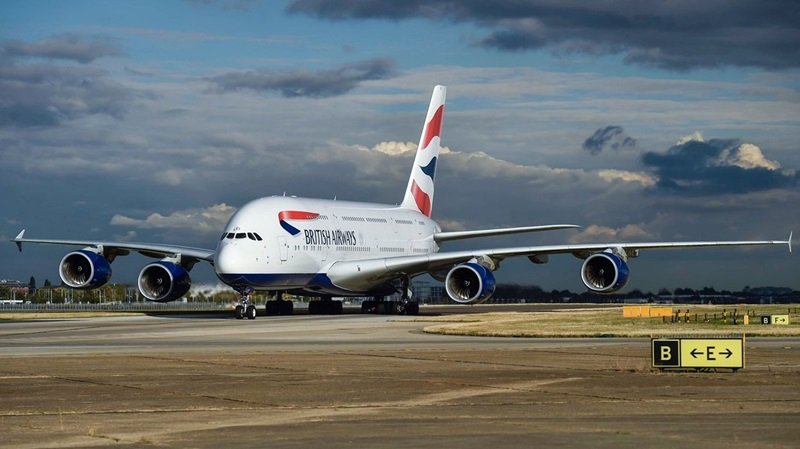
Airbus A380
Super Jumbo.
SPECS
ASSEMBLY
INTERIOR
HISTORY
ORDERS
The Airbus A380 started as far back as 1988 when Airbus, an EADS company, realised that they needed to come up with an answer for the stranglehold that Boeing had over the upper end of the aviation market with the Boeing 747. At the 1990 Farnborough Airshow, the Mega Project was announced. Designers from Airbus's four partners Aérospatiale, Deutsche Aerospace AG, British Aerospace, and CASA were invited to put forward new technologies that might be incorporated into this project.
In 1993 Boeing and several Airbus-related companies formed a feasibility study group for a Very Large Commercial Transport (VLCT). This was seen as a small market and one possibly not worth pursuing by one company alone. Boeing dropped out after two years as they saw that the investment was very unlikely to be recouped by sales later on, so they continued plans to further stretch and develop the Boeing 747.
Emirates is by far the largest customer of he Airbus A380 with 123 of the type in service.
Airbus in June 1993 began the development of their own large airliner which was designated A3XX. Several unusual designs were put forward, one being the twin fuselages of two A340s attached side by side. The Asian economic downturn of the late 1990s prompted the design to not only be very large but also to concentrate on the reduction of operating costs. Airbus targeted a 15% drop in running costs for this new design.
A newly restructured Airbus Industrie on 19 December 2000 voted the EU 8.8 Billion program into being and the A3XX was re-designated the A380. The logical progression of the Airbus type number should have made it the A350 as the A340 was the then-latest Airbus design. It was decided that the number 8 best represented the layout of the twin-deck design, as well as being a lucky number in Asia which was the target market for this aircraft.
Singapore Airlines was the launch customer for the Airbus A380 with their first route being the Singapore to Sydney, Australia run.
The A380 design was finalised in early 2001, and the first structural components were laid down on 23 January 2002.
Airbus intended to offer the A380 initially in two versions:
The A380-800 which in a three-class configuration can carry 555 passengers or if configured as all economy this can raise the total to 853. In May 2007 Airbus also offered a configuration with 30 fewer passengers which added a further 370Km (200 nautical miles) to its range. The range of this aircraft is 15,400Km (8,300 nautical miles) which is equivalent to flying Hong Kong to New York.
The A380-800F which was designed to carry 150 tonnes of cargo over a range of 10,400 Km (5,600 nautical miles) was put on hold while Airbus concentrated on the passenger side of the market. The cargo idea was never reinvestigated.
There was also an A380-900 stretch version on the drawing board which could carry 656 passengers in a three-class configuration or 960 passengers in an all economy version. The current wing area already is rated for the extra weight this would incur, however, strengthening of certain areas would still need to be undertaken. As we now know, this idea also never saw the light of day.
Airbus Industrie is a consortium formed by E.A.D.S. and BAe Systems. E.A.D.S., the European Aeronautic Defence and Space Company, was formed by a merger of Aerospatiale-Matra of France, Daimler-Chrysler Aerospace of Germany, and CASA of Spain (former members of Airbus). In October 2006, BAe Systems completed the sale of its shareholding to E.A.D.S., which is now the sole owner of Airbus.
ASSEMBLY
Singapore Airlines Airbus A380-841 Registration 9V-SKA was the world’s first commercial A380 delivered 16-Oct-2007 seen here climbing out from Sydney.
Airbus Parts Come Together.
Airbus's A380 aircraft sections are transported from sites in Broughton (UK), Hamburg (Germany), Puerto Real (Spain), and St. Nazaire (France) in a specially constructed huge roll-on / roll-off vessel (ro-ro), the "Ville de Bordeaux", built by Jinling Shipyard in Nanjing, China.
Map showing many of the main parts of the Airbus A380 are transported to be assembled in Toulouse.
The Airbus A380 fuselage forward and centre sections are barged up river from the Port of Bordeaux.
SPECIFICATIONS
The A380-800 as the Airbus A380 Specs table below will show, has a standard seating layout for 555 passengers on two decks in a three-class configuration. This varies from airline to airline. QANTAS, for example, has fitted its aircraft out with 523 seats in three classes. The A380 has 49% more floor area but only 35% more seats than the Boeing 747-400 which it was set to compete against (this is in the 555-seat configuration). This was envisaged to allow more room for passenger amenities such as bars, gymnasiums, and duty-free shops at the airline's discretion. Of course, these amenities are all very well at the conceptual stage, but economic pressures add a bit of a reality check and to date, no airline has added these amenities, save for First Class cabins on Emirates and Singapore Airlines.
Upgrade Options.
In April 2018 Airbus announced plans to offer passenger sleeping berth modules that would be able to be slotted into the cargo hold. These modules would be able to be inserted and removed just like cargo containers and could be slotted in for certain legs of a flight. As well as sleeping berths there could be options to slot in conference rooms, and lounge areas, to name a few. We feel that economics will somehow come back into play and that the airline company accountant might be hard-pressed to find a justification for leaving cargo behind in favour of some added passenger comfort. Unless of course, the airline can convince their travelling public to pay enough of a premium for these extra services. With the downturn in travel due to Covid 19 and the reduction of interest by airlines in large four-engined aircraft, we now know that Airbus has ended the A380 program once present orders for the aircraft type are filled.
Specs Engines.
The aircraft is equipped with four 70,000lb thrust engines, either the Rolls Royce Trent 900 or the General Electric / Pratt & Whitney Engine Alliance GP7200. Rolls Royce delivered the first Trent 900 engine in February 2004 and it made a successful first flight on an A340-300 test bed in May 2004.
Goodrich supplies the engine sensor system for the Rolls-Royce Trent 900 and Ametek the sensor system for the Engine Alliance GP7200. BAe supplies Systems Controls and Hispano-Suiza provides the FADEC (Full Authority Digital Electronic Control) system for the GP7200.
A QANTAS (Queensland And Northern Territory Air Services) Airbus A380 taxis for runway 34 Left at Sydney. The appreciation of sheer size of this aircraft makes you feel very small. Also, notice the droop of the wings, they are very full of fuel for a long-haul flight. During the takeoff run as the wings start to create lift, you will see them start to flex up as they take the weight of the aircraft.
Noise.
The take-off length for the Airbus A380 800 is 2,900m at maximum weight at sea level, ISA +15° conditions and the initial cruise altitude is 35,000ft. The aircraft complies with the noise emission limits of ICAO (Chapter 3, Schedule 16) for overflying, approach, and side-on maneuvers including stricter regulations of London Heathrow airport concerning take-off and landing. This enables aircraft operations at night.
There are ten fuel tanks with a capacity of 320,000 Litres of fuel. Refuelling can be carried out in 40mins.
The first Singapore Airbus A380-800 arrived in Sydney from Singapore in October 2007.
Landing Gear.
The 22-wheel Goodrich landing gear consists of two under-wing struts each with four wheels, two central under-fuselage struts each with six wheels and a twin nose wheel. Each landing gear supports about 167tonnes. Messier-Dowty supplies the nose landing gear with 350bar hydraulic pressure and Messier-Bugatti the braking and steering systems. Smiths Aerospace supplies the landing gear extension and retraction system. The load on the airport runways and aprons are of similar magnitude to that of a 747. ELDEC of Lynnwood, Washington, provides the landing gear proximity sensing system.
The aircraft can complete a 180° turn within a width of 56.5m, which is within the 60m width dimension of standard runways. The maximum operating speed is Mach 0.89 and the range is 15,000km or 8,000nm with the maximum number of passengers. The turnaround time at the airport terminal, including passenger disembarkation, cleaning, restocking and embarking the passengers for the next flight is a minimum of 90 minutes.
A Korean Airlines A380-800 on approach.
Airbus A380 Plus.
In order to make the A380 even better and naturally more saleable to airlines, Airbus undertook a program of updates and improvements. These A380 Plus updates had one main focus and that was the economy of operation. Whilst there was a sector of the market that benefited from the luxury offers of deluxe personalised cabins and the like, a strong case for using the A380 is its capability of moving a huge number of people for a relatively low cost. Airbus expected a 4% saving on fuel burn and with several other modifications a per seat saving on overhead costs of 13%.
So what is the A380 Plus and how did it differ from the current A380?
Firstly, aerodynamics. The A380 might be seen as rather curious as it did not come to market originally with winglets. Winglets offer the ability to generate more lift without adding substantially to wingspan. Too much wingspan, of course, incurs the need for wider gate areas at airports which is a huge additional overhead. The generation of more lift, of course, is a major factor in reducing fuel burn. The design of the winglets is similar to the split configuration of the Boeing 737 MAX, with the larger upward-pointing winglets (uplet) being 3.5 metres and the downward-pointing winglets (downlet) being 1.5 metres.
This additional lift also gives the opportunity to carry more payload. To this end, Airbus is increasing the available deck space in the passenger cabin by, making the fore and aft staircase more functional so they take less space. So, gone is the nice sweeping staircase in the rear. Also where there are bins beneath the windows, these will now be removed giving more available space to the width of the cabin. The improved lift will enable an increase to the Maximum Take-Off Weight (MTOW) of 570 tonnes which could be translated to varying 80 more passengers or flying 300nm further than today's range of 8,200nm. Airbus says that the average seat configuration chosen by airlines is 497 in total and that this could rise to 575 in the A380 Plus.
Emirates have been pressuring Airbus for a NEO (New Engine Option) version of the A380, however, Airbus was reluctant to commit to the huge development costs while sales of the aircraft were so soft. The A380 Plus features went some way to achieving the economic savings airlines were looking for, however, as we now know it was not enough to keep the A380 relevant in today’s market.
A380 Specs Table
| Typical Seating | 555 passengers |
| Airbus A380 Price (average) | US$375.3 Million |
| Flight Crew | 2 |
| Length | 73 Metres (239 Feet 6 Inches) |
| Height | 24.1 Metres (79 Feet) |
| Fuselage Diameter | 7.14 Metres (23 Feet 5 Inches) |
| Cabin Length | 50.68 Metres (166 Feet 4 Inches) |
| Maximum Cabin Width, Main Deck | 6.58 Metres (21 Feet 6 Inches) |
| Maximum Cabin Width, Upper Deck | 5.92 Metres (19 Feet 11 Inches) |
| Wheel Base | 30.4 Metres (99 Feet 9 Inches) |
| Track | 14.3 Metres (46 Feet 11 Inches) |
| Wing Area | 843 Square Metres (9,096 Square Feet) |
| Wing Span | 79.8m (261 Feet 10 Inches) |
| Sweep, 25% of Chord | 33.5% |
| Maximum Ramp Weight | 562,000kg (1,238,998lb) |
| Maximum Take-off Weight | 560,000kg (1,234,600lb) |
| Maximum Landing Weight | 386,000kg (850,984lb) |
| Maximum Zero Fuel Weight | 361,000kg (795869lb) |
| Maximum Fuel Capacity | 320,000 Litres (84,535 U.S. Gallons) |
| Typical Operating Empty Weight | 277,000kg (610,700lb) |
| Typical Volume Payload | 664,000kg (1,463,869lb) |
| Powerplants. | A380-800 - Four 311kN (70,000lb), initially de-rated to 302kN (68,000lb), later growing to 374kN (84,000lb) thrust
Rolls-Royce Trent 900 or 363kN (81,500lb) thrust Engine Alliance (General Electric-Pratt & Whitney) GP-7200 turbofans. |
| Range with Maximum Number of Passengers. | 15,000 Km (8,000 Nm) |
| Maximum Operating Speed. | 0.89 Mach |
| Long Range Cruising Speed. | 0.85 Mach |
| Service Ceiling. | 43.000ft (13,100m) |
| Total Freight and Cargo Volume. | 171 Cubic Metres (6,039 Cubic Feet) |
| Bulk Hold Volume. | 18.4 Cubic Metres (650 Cubic Feet) |
| Maximum Volume of Pallets. | Under Floor 13 Pallets |
| Container Capacity. | Underfloor 38 LD3 containers |
Cutaway.
| Date | Event |
|---|---|
| 1988 | A team of engineers at Airbus began work to design an ultra-high-capacity airliner (UHCA) to compete with Boeings' 747 stranglehold of that market. |
| Sept 1990 | The announcement to go ahead with an ultra-high-capacity airliner (UHCA) project was made at the Farnborough Airshow. |
| Jan 1993 | Boeing and several Airbus-related companies start a joint study into a Very Large Commercial Transport (VLCT). |
| Jun 1994 | Airbus announce they will be going it alone to develop their own Very Large Commercial Transport (VLCT) which they designated the A3XX |
| 19 Dec 2000 | The board of the newly restructured Airbus approved €8.8-billion to go ahead with the rechristened A380 project. |
| 23 Jan 2002 | The design having been finalised the previous year, construction starts on the first wing box. |
| 18 Jan 2005 | The first of 5 test A380s was unveiled in Toulouse. Her registration was F-WWOW. |
| 27 Apr 2005 | The maiden flight of the A380, registration F-WWOW, took place at 10:29 am, French time, and lasted 3 hours and 54 minutes. This was using Rolls-Royce Trent 900 engines. |
| Jun 2005 | Customers for the A380 were advised to expect a 6-month delay due to wiring problems. |
| 01 Dec 2005 | The A380 achieved its maximum design speed of Mach .96 in a shallow dive. |
| 10 Jan 2006 | First trans-Atlantic test to José María Córdova International Airport in Colombia. |
| 06 Feb 2006 | Cold climate testing was performed at Iqaluit, Nunavut in Canada. |
| 14 Feb 2006 | Stress testing of the wing revealed that the wing broke at 146% of the required level instead of 150%. Further strengthening was added which increased the weight by 30Kg. |
| 26 Mar 2006 | In Hamburg a test with 853 passengers and 20 crew managed to evacuate a darkened A380 with half the exits blocked in 78 seconds. The requirement is for this to be achieved in under 90 seconds. |
| 29 Mar 2006 | Type approval for the A380 was received from both the European Aviation Safety Agency (EASA) and United States Federal Aviation Administration (FAA). |
| 13 Jun 2006 | A380 customers were advised of a further delay with slippage of a further 6 to 7 months. |
| 25 Aug 2006 | A380, registration F-WWEA first flew using the Engine Alliance GP7200. Engine Alliance was a 50/50 alliance between General Electric and Pratt and Whitney. |
| 04 Sept 2006 | Passenger facilities and comfort testing began using 474 Airbus employees. |
| 03 Oct 2006 | A third delay of the A380 was advised to customers with the first delivery being slated for October 2007. |
| 15 Oct 2007 | The first Airbus A380, registration 9V-SKA, was delivered to launch customer Singapore Airlines. |
| 25 Oct 2007 | The first commercial flight of the A380 took place from Singapore to Sydney. All seats were auctioned off for charity. |
History.
The 555 seat, double deck Airbus A380 aircraft is the most ambitious civil aircraft program yet. On entering service in October 2007, the Airbus A380 was and is the world's largest airliner, easily eclipsing Boeing's 747.
Airbus first began studies on a very large 500 seat airliner in the early 1990s. The European manufacturer saw developing a competitor and successor to the Boeing 747 as a strategic play to end Boeing's dominance of the very large airliner market and round out Airbus' product line-up. Airbus began engineering development work on such an aircraft, then designated the A3XX, in June 1994. Airbus studied numerous design configurations for the A3XX and gave serious consideration to a single deck aircraft which would have seated 12 abreast and twin vertical tails. However, Airbus settled upon a twin deck configuration, largely because of the significantly lighter structure required. Key design aims include the ability to use existing airport infrastructure with little modifications to the airports, and direct operating costs per seat 15-20% less than those for the 747-400. With 49% more floor space and only 35% more seating than the previous largest aircraft, Airbus is ensuring wider seats and aisles for more passenger comfort.
Using the most advanced technologies, the A380 is also designed to have 10-15% more range, lower fuel burn and emissions, and less noise. The A380 would feature an advanced version of the Airbus common two crew cockpit, with pull-out keyboards for the pilots, extensive use of composite materials such as GLARE, and four 320 to 347kN (72,000 to 78,000lb) class Rolls Royce Trent 900 or Engine Alliance (General Electric/Pratt and Whitney) GP-7200 turbofans.
Several A380 models were planned: the basic aircraft is the 555 seat A380-800 and high gross weight A380-800, with the longer range A380-800R planned.
Future models were to include the shortened, 480 seat A380-700, and the stretched, 656 seat, A380-900. (The -700, -800, and -900 designations were chosen to reflect that the A380 will enter service as a fully developed aircraft and that the basic models will not be soon replaced by more improved variants). A380 final assembly took place in Toulouse, France, with interior fitment in Hamburg, Germany. Major A380 part assemblies are transported to Toulouse by ship, barge and road.
First 2 Airbus A380s of Singapore Airlines pass each other in Sydney
The A380 Airbus interior has twin-aisle cabins on the upper and lower decks, with 49% more floor space for 35% higher seating capacity compared to the Boeing 747-400.
A three-class layout provides 555 seats. A typical upper deck layout provides 96 business- and 103 economy-class seats. The main deck provides 22 first-class seats and 334 economy-class seats.
Two stairwells link the passenger decks. A lifting system between passenger decks provides access for passengers with limited mobility. There is also a cargo hoist linking the two passenger decks.
The size of the Airbus A380 makes possible a number of configurations and passenger facilities. Singapore Airlines (launch customer) has a configuration for 471 passengers – 12 first-class 'suites' and 311 economy seats on the main deck, 60 business class seats and 88 economy seats on the upper deck.
Naturally, every airline customer will have their own cabin layouts, furnishings, and colours chosen when they order their version of the Airbus A380. Airbus has showcased some of the modern advances in aircraft interior design and technology creating a sensation of freshness and space.
Cabin Interior.
Orders and Deliveries.
Airbus announced in February 2019 that the production of the Airbus A380 would cease in 2021. After eleven years due to the soft Airbus A380 Orders and Deliveries, Airbus has made the hard decision.
When the A380 was launched, it was anticipated that 1,200 of the type would be produced, which would have covered development, construction and profit. The truth is that less than a quarter of that number were ordered. In the last months, we have seen airlines cancel their orders. Notably, QANTAS who received 12 of the 20 they ordered, has now cancelled the remaining 8. Virgin Atlantic cancelled their order of 6. Even Emirates, the largest customer of the type with an order of 162, are talking about reducing this order in favour of the Airbus A350-1000.
So why has the A380 not sold? There are several factors. Firstly, the expense of an aircraft that requires 4 engines to run. The overhead is far higher than the large twin-engine jets which are becoming more popular. Airlines are also challenged to fill each flight with over 500 seats to ensure profitability. In addition, airfields that can accommodate the Super Jumbo had to be heavily modified to accommodate the large jet. The theory behind the use of the A380 was dependent on a hub and spoke system. The A380 would fly between main hub cities. Travellers would then connect on to smaller regional centres. The emerging reality, however, is that many of the larger long-range twin jets can fly virtually anywhere using existing airfield facilities.
So it seems, just like the Boeing 747 8i, the A380 has been overtaken by changes in technology and market demand. The time of the oversized airliner is over.
Below are the first 8 customers to take the first delivery of these flagships of their fleets.
Order Book.
Correct as at end of August 2022.
| Total Orders | 251 |
| Total Deliveries | 251 |
| Aircraft in Operation | 239 |
| Number of Operators | 16 |
| Number of Customers | 14 |
Airline Customers of the A380.
Correct as at end of August 2022.
| CUSTOMER | Region | A380 | |||
| Ord | Del | Opr | |||
| AIR FRANCE | FRANCE | Europe | 10 | 10 | 7 |
| ALL NIPPON | JAPAN | Asia | 3 | 3 | 3 |
| ASIANA AIRLINES | KOREA, REPUBLIC OF | Asia | 6 | 6 | 6 |
| BRITISH AIRWAYS | UNITED KINGDOM | Europe | 12 | 12 | 12 |
| CHINA SOUTHERN AIRLINES |
CHINA | Asia | 5 | 5 | 3 |
| EMIRATES | UNITED ARAB EMIRATES | Mid. East | 123 | 123 | 120 |
| ETIHAD AIRWAYS | UNITED ARAB EMIRATES | Mid. East | 10 | 10 | 10 |
| KOREAN AIR | KOREA, REPUBLIC OF | Asia | 10 | 10 | 10 |
| LUFTHANSA | GERMANY | Europe | 14 | 14 | 14 |
| MALAYSIA AIRLINES | MALAYSIA | Asia | 6 | 6 | 6 |
| QANTAS AIRWAYS | AUSTRALIA | Asia | 12 | 12 | 12 |
| QATAR AIRWAYS | QATAR | Mid. East | 10 | 10 | 10 |
| SINGAPORE AIRLINES | SINGAPORE | Asia | 24 | 24 | 17 |
| THAI | THAILAND | Asia | 6 | 6 | 2 |
| UNDISCLOSED | 0 | 7 | |||
| TOTALS | 251 | 251 | 239 | ||











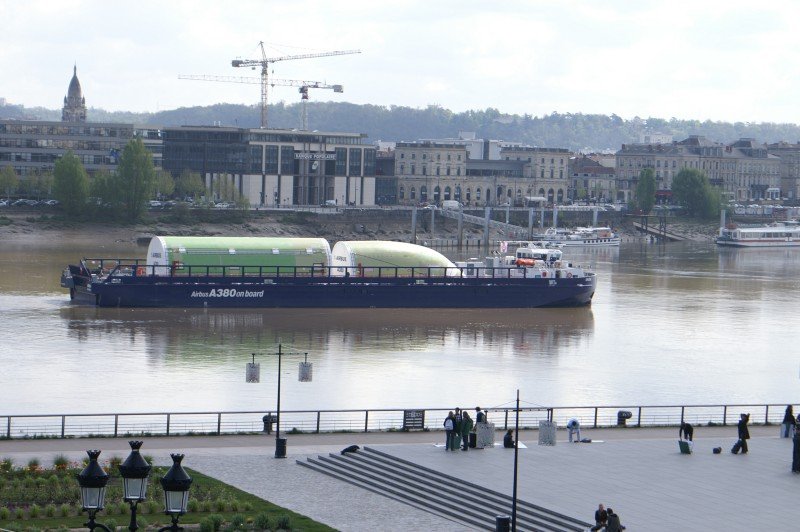


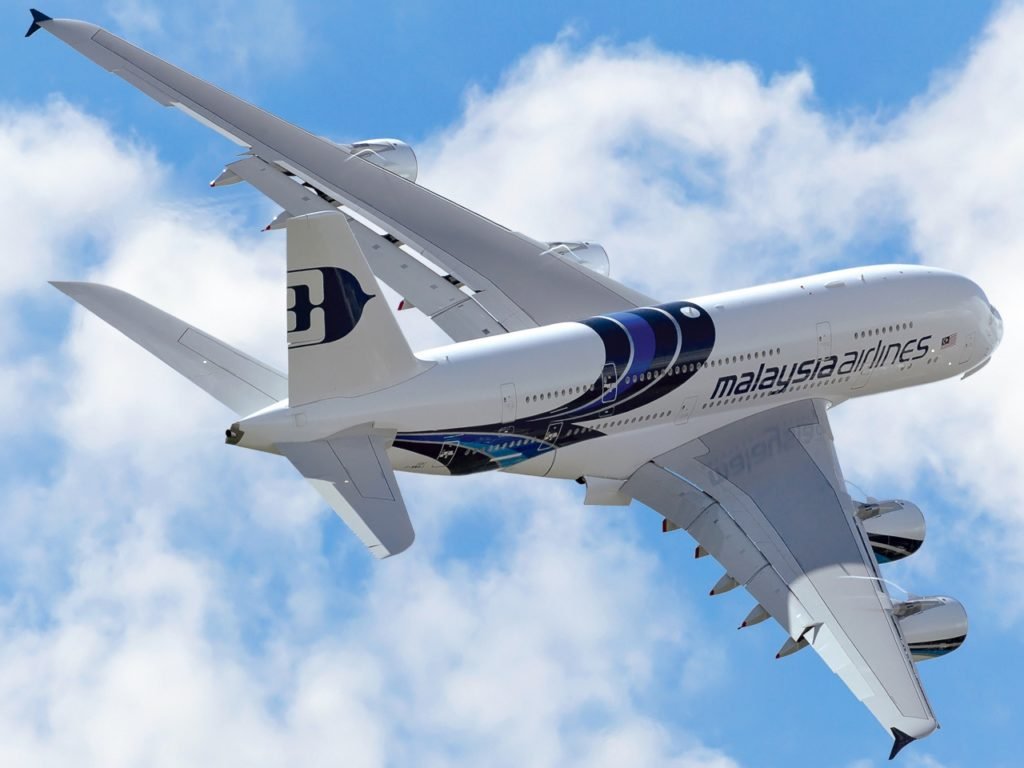

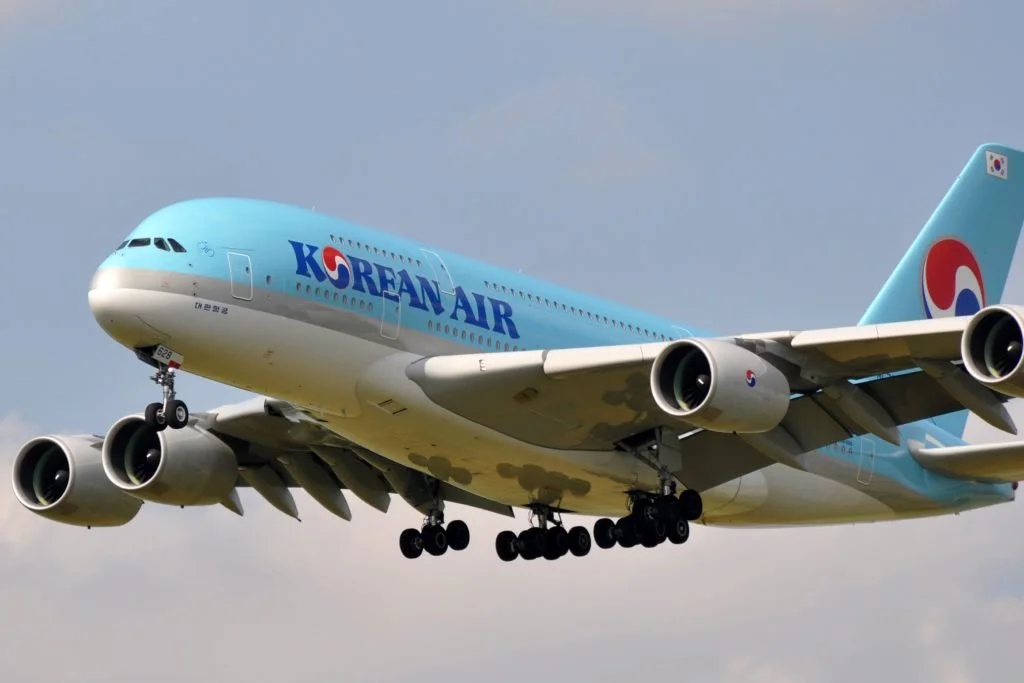
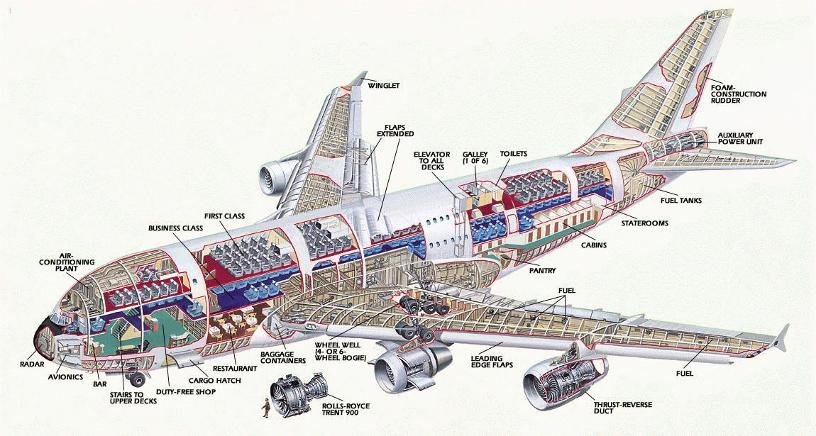
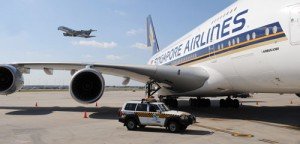









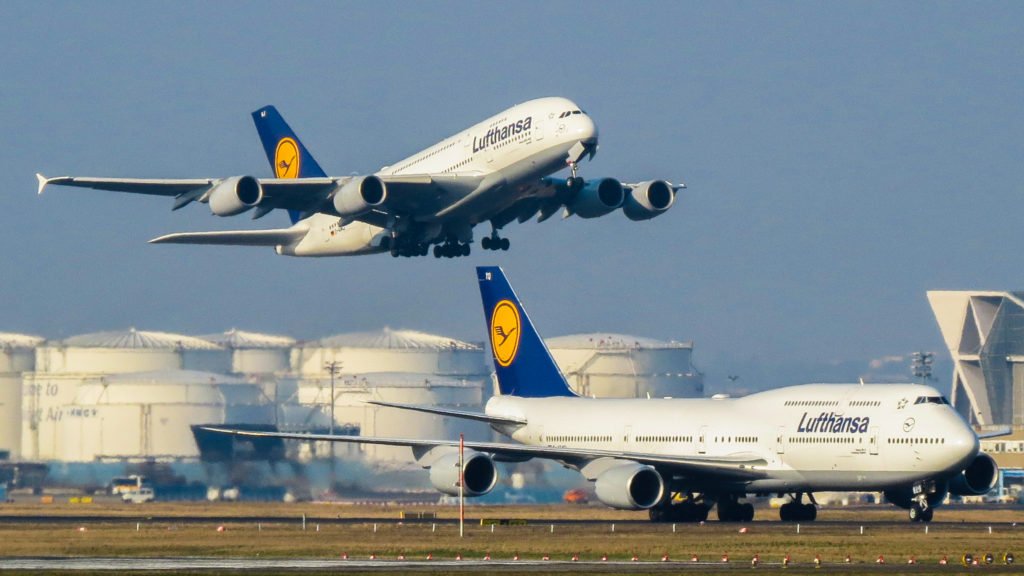




Airbus A380 First Class bar area.